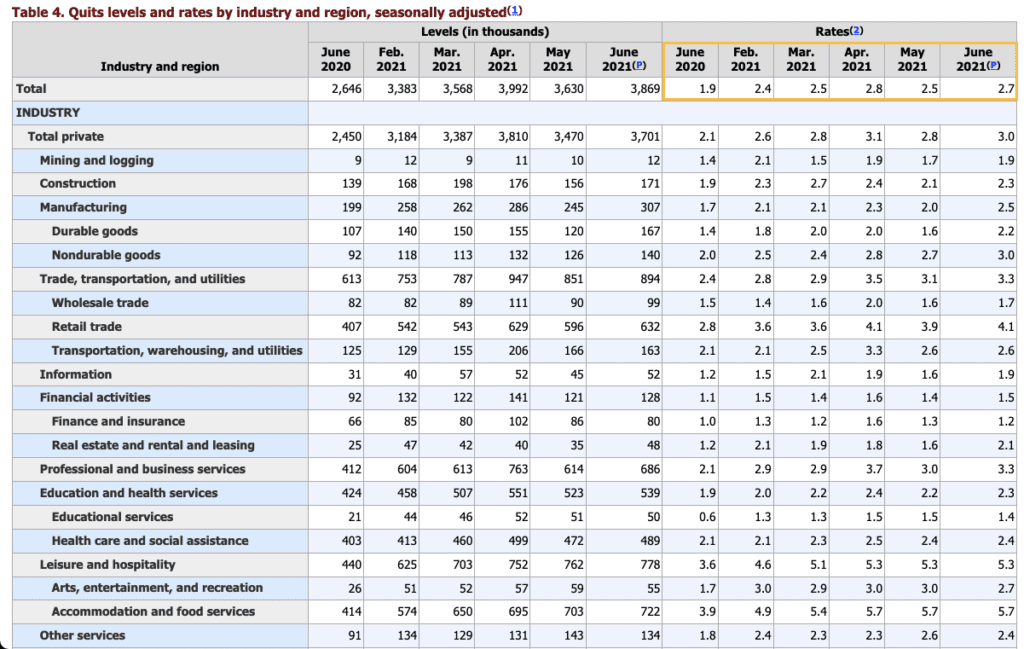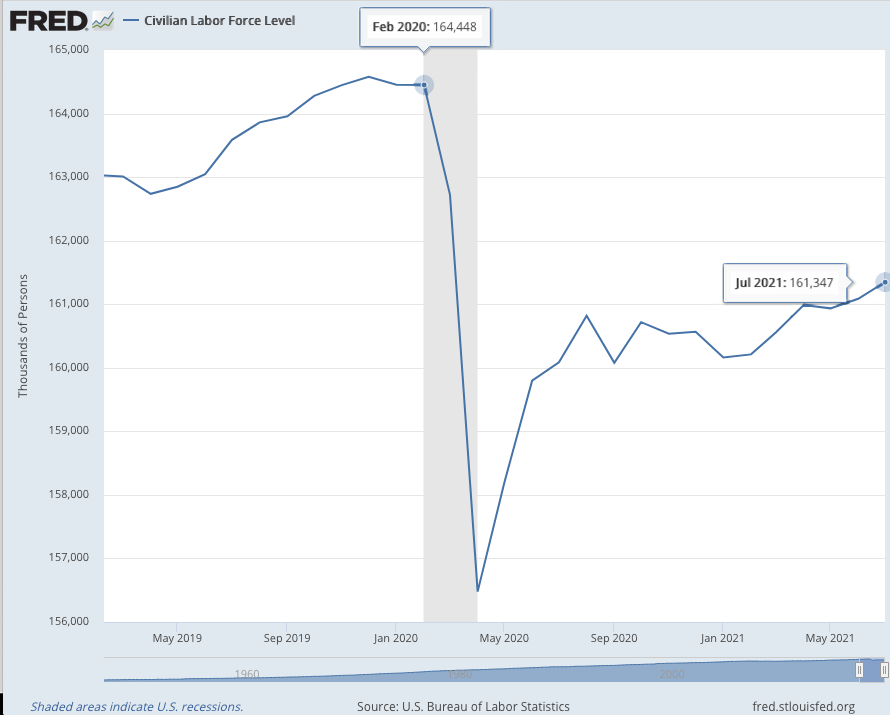
Home » Can’t find people to hire? It helps to understand complexity of labor market
Can’t find people to hire? It helps to understand complexity of labor market

September 13, 2021
Despite the challenges with the Covid-19 Delta variant, companies continue to add jobs – a good sign of economic stabilization.
Unfortunately, we’re also facing the greatest disruption in the labor market in a century. Employers cannot find enough people to fill their open positions. One would think the math is easy when the number of open jobs is greater than the number of unemployed people. And yet, it’s not so simple. Nor is it as simple as stopping federal monies or increasing worker pay.
However, there is hope for employers through skills-based hiring and unique partnerships.
While enjoying a coffee with my husband over the weekend, we met a local farmer and enjoyed a long conversation primarily about the current challenges presented in agriculture in the West during the driest, hottest year on record. He said he’s grateful that his federal crop insurance will cover 85% of his yield, given the significant losses he will have.
He then asked what we did for a living. I gave my quick spiel about WholeStory and how we help employers hire for soft skills. The farmer responded with a remark about how employers are struggling to hire because people are “sitting at home getting paycheck from the government.”
(Pause for irony.)
Most people are unaware of the macro forces at play in the current labor market. This includes many perplexed employers, especially those who are raising wages and still not seeing enough applicants to fill their roles.
Like the farmer, I used to see things as black and white. I shared the perspective, concern, and assumption about people’s work ethic.
Today, my understanding is much more nuanced.
Through my work with WholeStory, I’ve been steeped in labor market trends. My education has deepened over the last year as the issues employers face nationwide have been exacerbated, accelerating and growing in complexity due to the pandemic.
First, the elephant(s) in the room.
Supplemental federal unemployment insurance benefits and federal stimulus checks have certainly played a role in labor market dynamics. It’s estimated that 25% of those on unemployment were making more money than at their previous job when considering the additional federal monies. By and large, the jobs that these folks had were low-wage and offered little to no health benefits. It doesn’t take a rocket scientist—or better yet, a social psychologist—to conclude that many folks would take this opportunity to hold back. However, the data suggests there are bigger factors at play, which I’ll dig into.
We’re still in the midst of a global pandemic. People are rightly concerned about getting sick and/or transmitting Covid to others. Until it’s over everywhere, it’s not over anywhere. For workers, especially those barely scraping by in industries that require frequent engagement with others, such as in retail, restaurants, and hospitality, it’s no wonder people are hesitant. They’re in a tough spot: work and risk their health/life and the health/lives of their loved ones, or wait and hope that they can figure out a new path before unemployment runs out.
Second, the workers have left the building.
The Great Resignation
The stress and clarity that this crisis has brought about in many is leading to what some are calling “The Great Resignation.” Millions of people are leaving their jobs every month. At a rate of 2.7% to be exact, the highest since 2000. This is especially true in health care, restaurants, hospitality and education but it reaches into nearly every sector.
As mentioned above, people are concerned about their health and switching to jobs that do not require as much engagement with others. Many are using this moment to more deeply align their work with their values, priorities and desires. In industries where workers were able to work remotely but are now being forced back to the office, many are opting for more flexible, remote-friendly jobs. People have realized that life is short – work is not worth sacrificing their health, family or values if they are able to go elsewhere.

Roughly 1.5 million people over the age of 55 have taken severance packages and retired early. Similar to other groups, many older workers have simply decided it’s no longer worth it. The gap left behind by Baby Boomers in particular presents a huge risk to employers who do not have strong succession plans in place. There are not as many mid-level workers to fill the shoes of those retiring.
For women, the pandemic created an impossible situation. More than 2 million women permanently left the workforce in 2020 to care for sick or at-risk loved ones and/or their children who were out of school and day care. Women, especially those with children, were much more likely to leave than men.
That’s not to mention the overall shrinking workforce due to declining birth rates, a trend over the last decade. Between those retiring and women leaving, the overall labor market participation rate dropped 1.7%, which may not sound like much but represents 3.1 million workers.

All of these factors have created a cataclysmic shift in power dynamics between employers and employees. We’re in the midst of a labor market reckoning. Job seekers and employees are now in the driver’s seat. And they’re not stopping without good reason – higher wages, improved benefits, better hours, flexible schedules, transparent and effective health and safety policies, etc.
Raising wages and boosting benefits only helps to a degree. It’s not panacea and certainly comes with constraints for some small businesses. Several industries simply do not have enough skilled workers. This is especially acute in health care, manufacturing, construction and many of the trades. A decline in apprenticeships, lower interest in these jobs and advances in technology (namely automation) are some of the major factors. The effects of the pandemic accelerated what was a 10- to 20-year projection, condensing it down to just a few months. In addition, some other industries are also less desirable, like retail, restaurants and hospitality. Higher wages don’t reduce health risks, improve shifts or ensure predicable schedules.
Along the lines of declining apprenticeships, the turn of the 21st century brought about the end of internal training and leadership development programs. Many companies stopped creating distinct career pathways to help people move up. Instead, they expected people to show up “work ready.” In some instances, this may be an effective model but in many, it’s created significant hurdles for recruitment to not just find people to do the job, but to do it well.
In the throes of the sharp, deep recession in mid-2020, many people separated from employers in layoffs, furloughs, quitting and business closures. There were 110,000 restaurants that permanently shut down in 2020 alone, resulting in 2.5 million jobs lost. What many employers are not fully aware of, is that when an employee relationship is severed, it is exponentially more difficult to reconnect it. Many people went out and found new jobs, went back to school or dropped out of the workforce altogether. The rest were left looking for jobs in new industries, struggling to match or translate their skill set.
A labor mismatch
The last factor I’ve observed is not as obvious but no less important: most employers are too narrowly focused on “qualifications” that have little to no bearing on performance. Things like brand name schools, previous industry experience and, in some industries, level of education and degrees themselves. This tight aperture excludes 70 million people who’ve been skilled through alternative routes and have the potential to transform teams.
While the number of jobs listed exceeds the number of people unemployed (and maybe even including those underemployed), it’s not a one-to-one match. We don’t have the right people with the right skills. Rather than a labor shortage, what we have is a labor mismatch.
What’s an employer to do?
Thankfully, there are two simple yet strategic actions employers can take to mitigate their risk. First, employers must shift toward skills-based hiring, allowing for life experience as a job qualification. Second, employers must connect with job training programs, which are growing in capacity yet historically underutilized.
In every crisis lies opportunity. For employers, this is a moment to truly differentiate – in values, candidate experience and follow through.
Employers must signal to job seekers that they value them and their employees as people. And, here’s the real kicker, follow through with authentic actions. The impact this will have on employer branding cannot be overstated.
Skills-based hiring offers a win-win scenario. Employers can identify and hire the right people for the right jobs while expanding the aperture for who qualifies. This is especially powerful for job seekers who are underrepresented or come from non-traditional backgrounds. Skills-based hiring focuses on the skills an individual already possesses rather than focusing on how they acquired them. These can be both technical and soft skills.
To understand what those skills are, employers must look at the broad experiences candidates gain through life. Learning about an individual’s life experiences is a powerful mechanism for both human connection and assessing soft skills. Before this is dismissed as some soft and fluffy kumbayah thing, know that life experience is the most effective and powerful way to understanding people and their soft skills.
For some companies, developing in-house training, internships or apprenticeship programs may be a viable path to getting new hires up to speed. However, for most, it likely will be a long and costly road that cannot address acute needs. Workforce development programs are strategically positioned to meet this moment and to meet employers where they are.
There are roughly 10,000 private and nonprofit job training programs nationwide. In addition, we have an extensive, established public workforce development system at our fingertips here in the U.S. These programs and organizations provide training in every industry and represent millions of job seekers.
As part of our work, we partner with workforce development programs across the country to help prepare their job seekers for the interview.
These organizations have the capacity to come alongside employers and ensure a clear, consistent, diverse and outstanding talent pipeline. Given the difficulty in finding the private and nonprofit outfits, we’re building The National Database of Workforce Development and Job Training Programs.
So far, we have over 340 organizations identified, and we’re adding to it every week. Go to: bit.ly/WorkforceJobTrainingDatabase.
Here is a snippet from Washington state:
Organization | Website | Skills Focus |
Ada Developers Academy | Tech | |
Career Path Services | BankWork$, Financial Services, General, Healthcare | |
Counsel for Adult and Experiential Learning (CAEL) | EPCE, Energy, General, NACTEL, Telecommunications | |
Floodgate Academy | Tech | |
Generation USA | Tech | |
Orion | Aerospace | |
Skills Inc. | Aerospace, Business Operations, Manufacturing | |
Unloop | Tech | |
Vets2PM | PMI-ACP®, PMP®, Project Management, Tech | |
Washington State Opportunity Scholarship (WSOS) | Healthcare, STEM | |
Year Up | Business Operations, Customer Service, Financial Services, IT - Information Technology, Sales, Soft Skills, Software Development, Tech |
Like most macro-level problems, the challenges in the labor market today are not simple. They’re perhaps as complex as they’ve ever been.
While there is no quick fix to a multifaceted problem like this, there are simple yet impactful steps employers can take to ease the acute pain felt: shift the hiring practice to be inclusive of life experience, and partner with the many workforce development organizations out there who are ready and eager to connect.
Erin Anacker is the cofounder and head of product at WholeStory, a technology platform that provides insight into diverse life experiences to power better hiring, based in the Tri-Cities.
Local News
KEYWORDS september 2021




